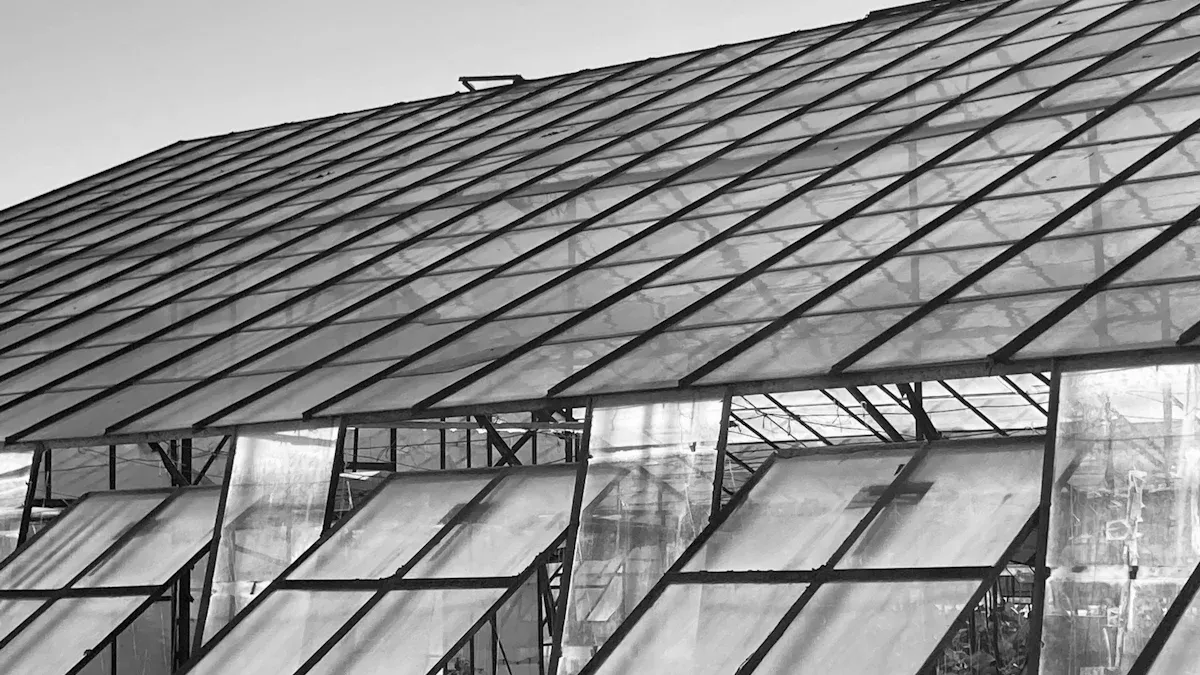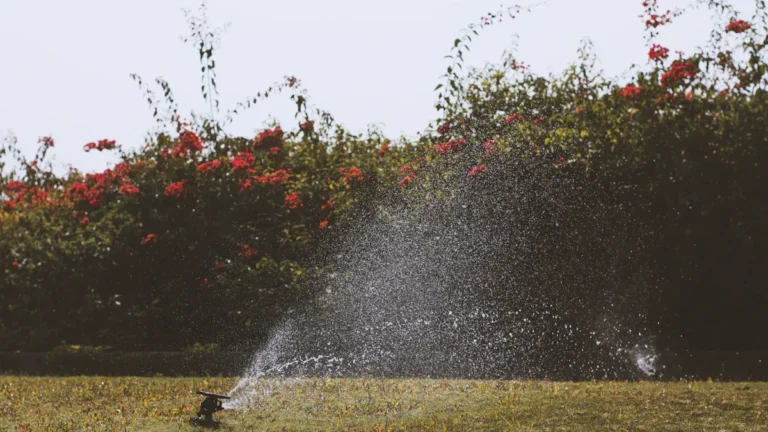Greenhouse Materials Compared: Durability, Cost, and Light Transmission
Compare greenhouse materials like glass, polycarbonate, and plastic film for durability, cost, and light transmission. Find the best option for a greenhouse for sale.

Selecting the right material for your greenhouse is crucial for maximizing plant growth and ensuring long-term performance. Materials like LDPE films, known for excellent light diffusion and cost-efficiency, dominate the market. Their durability and insulation capabilities enhance crop yield and sustainability, making them a popular choice when exploring a greenhouse for sale.
Key Takeaways
Pick greenhouse materials that suit your area’s weather. For harsh weather, use strong materials like polycarbonate or fiberglass.
Think about the plants you plan to grow. Sun-loving plants do well with glass, while shade plants prefer polycarbonate.
Look at both starting costs and future expenses. Plastic film costs less at first but needs replacing sooner.
Overview of Common Greenhouse Materials

When choosing a greenhouse material, understanding the options available can help you make an informed decision. Each material offers unique benefits and challenges, depending on your needs.
Glass
Glass has been a traditional choice for greenhouses for decades. It provides excellent light transmission, allowing nearly 90% of sunlight to pass through. This makes it ideal for plants requiring high levels of natural light. Tuttavia, glass is heavy and fragile, which can increase installation and maintenance costs. It also lacks insulation properties, making it less energy-efficient in colder climates.
Polycarbonate
Polycarbonate is a popular modern alternative to glass. It is lightweight, durable, and offers better insulation. This material diffuses light, reducing the risk of plant scorching while maintaining optimal growth conditions. Polycarbonate panels are also more resistant to impact, making them suitable for areas prone to hail or strong winds. While it is more expensive than plastic film, its longevity often justifies the investment.
Poly Film/Plastic
Plastic film, also known as poly film, dominates the greenhouse market, covering 71% of structures globally. It is affordable, easy to install, and provides good light diffusion. Tuttavia, it has a shorter lifespan compared to glass or polycarbonate, often requiring replacement every 3-5 years. Despite this, its cost-effectiveness makes it a top choice for hobbyists and commercial growers alike.
Other Materials (e.g., Acrylic, Fiberglass)
Acrylic and fiberglass are less common but still viable options. Acrylic offers excellent light transmission and durability, while fiberglass provides good insulation. Both materials are lightweight and easier to handle than glass. Tuttavia, they can be more expensive and harder to find when searching for a greenhouse for sale. Their niche applications make them suitable for specific needs rather than general use.
Tip: Consider the market value of your crops when selecting a material. Horticultural crops account for 86% of greenhouse usage, so aligning your material choice with your crop type can maximize returns.
Detailed Comparison of Greenhouse Materials

Glass
Glass remains a classic choice for greenhouses due to its unmatched light transmission. It allows up to 90% of sunlight to pass through, creating an ideal environment for plants that thrive on high light exposure. Tuttavia, its durability and cost can vary based on the type of glass you choose:
Type of Glass | Durability | Cost Implications |
|---|---|---|
Standard Single-Pane Glass | Greatest longevity | Higher initial cost, but more frugal over time due to durability. |
Low-Iron Single-Pane Glass | Greatest longevity | Similar cost implications as standard glass, with better light transmission. |
Low-Iron Double-Pane Glass | Great longevity | More expensive, but insulated, potentially leading to cost savings in energy use. |
While glass offers excellent longevity, its fragility and weight make installation challenging. You may also face higher heating costs in colder climates due to its poor insulation properties. If you’re considering a greenhouse for sale in a region with mild weather, glass could be a worthwhile investment.
Polycarbonate
Polycarbonate has gained popularity as a modern alternative to glass. Its lightweight and impact-resistant nature make it a practical choice for areas prone to harsh weather conditions. This material also provides better insulation than glass, helping you maintain stable temperatures inside the greenhouse.
Polycarbonate panels typically transmit 79% A 81% of sunlight, which is slightly lower than glass. Tuttavia, this reduction in light is offset by its ability to diffuse sunlight, preventing plant scorching. Studies comparing greenhouse materials have highlighted polycarbonate’s superior performance in balancing light transmission and durability.
Type of Greenhouse Plastic | Light Transmission % | Lifespan (Years) |
|---|---|---|
Polycarbonate, 8mm Twin Wall | 79% – 81% | 4-6 |
Although polycarbonate is more expensive than plastic film, its extended lifespan and energy efficiency often justify the higher upfront cost. For long-term projects, this material offers a reliable and cost-effective solution.
Poly Film/Plastic
Poly film, or plastic, is the most widely used greenhouse covering material, thanks to its affordability and ease of installation. It is available in various thicknesses, each suited to different applications:
Application Type | Cost Efficiency and Durability Benefits | |
|---|---|---|
80-150 | Short-term applications | Cost-effective for seasonal crop protection; popular among small-scale farmers due to affordability. |
150-200 | Standard greenhouse covering | Balances durability and cost; enhances protection against UV and environmental stresses, suitable for various climates. |
200 and above | Long-term applications | Superior durability and thermal insulation; higher initial investment offset by extended lifespan and lower operational costs. |
Plastic film transmits up to 90% of sunlight, comparable to glass, but its lifespan is shorter, typically lasting 3-5 years. Despite this, its low cost makes it an excellent choice for hobbyists or growers looking for a budget-friendly option. For instance, 6 mil clear greenhouse plastic offers high light transmission and is ideal for maximizing photosynthesis in plants.
Other Materials
Alternative materials like acrylic and fiberglass cater to specific needs. Acrylic provides excellent light transmission and UV resistance, making it a durable option for regions with intense sunlight. Fiberglass, on the other hand, offers good insulation and weather resistance but may degrade over time without proper coatings.
Advantages | Disadvantages | |
|---|---|---|
Acrylic | Excellent transmissivity; Superior UV & weather resistance; Won’t yellow; Lightweight; Easy to fabricate on site | Easily scratched; High expansion/contraction; Slight embrittlement with age; High cost; Relatively low service temperatures; Flammability |
Fiberglass | Low cost; Strong; Superior weatherability only when Tedlar coated; Easy to fabricate & install | Susceptible to UV dust & pollution degradation; Yellows with age; High expansion/contraction rate |
These materials are less common and may not always be readily available when searching for a greenhouse for sale. Tuttavia, they can be ideal for niche applications, such as small-scale or experimental greenhouses.
Note: When selecting a material, consider your climate, crop type, and budget. Each material has unique strengths and weaknesses, so aligning your choice with your specific needs will ensure the best results.
Factors to Consider When Choosing a Greenhouse Material
Climate and Weather Conditions
Your local climate plays a critical role in determining the best greenhouse material. In regions with extreme weather, such as heavy snowfall or strong winds, durability becomes a top priority. Materials like polycarbonate or fiberglass excel in these conditions due to their impact resistance and insulation properties. Conversely, in mild climates, glass or plastic film may suffice, offering excellent light transmission without the need for heavy-duty protection.
Tip: If you live in an area prone to hailstorms, consider polycarbonate panels. Their impact resistance ensures your greenhouse remains intact during severe weather events.
Humidity and temperature regulation are equally important. Effective climate control allows you to maintain optimal growing conditions year-round. Materials with good insulation, such as double-pane glass or thick polycarbonate, help stabilize internal temperatures, reducing the need for additional heating or cooling systems.
Types of Plants Being Grown
The plants you intend to grow should heavily influence your choice of greenhouse material. Different crops have unique requirements for light, temperature, and humidity. For instance:
High-light crops like tomatoes and peppers thrive under glass, which offers maximum light transmission.
Shade-tolerant plants like lettuce or spinach benefit from materials like polycarbonate, which diffuse sunlight and prevent scorching.
Tropical plants require materials with excellent insulation, such as double-layer poly film, to maintain high humidity and stable temperatures.
Maintaining the right environment for your crops ensures healthy growth and higher yields. Greenhouses must regulate temperature and humidity effectively, as these factors directly impact plant health. For this reason, selecting the right material is essential to achieving optimal growing conditions.
Budget and Long-Term Costs
Your budget will likely dictate your choice of greenhouse material. While initial costs are important, you should also consider long-term expenses, such as maintenance and replacement.
Aspect | Cost Range |
|---|---|
Annual Maintenance Budget | |
Replacement of Covering | $5,000 A $50,000 or more |
Plastic film offers the lowest upfront cost, making it ideal for hobbyists or small-scale growers. Tuttavia, its shorter lifespan (3-5 years) means you’ll need to replace it more frequently. Glass and polycarbonate, though more expensive initially, provide greater durability and lower long-term maintenance costs.
Larger greenhouses often justify the higher investment in durable materials by yielding greater production volumes. If you’re considering a greenhouse for sale for commercial purposes, investing in high-quality materials can lead to better returns over time.
Availability of Greenhouse for Sale
The availability of materials in your region can also influence your decision. Glass and polycarbonate are widely available and cater to a range of greenhouse designs. Plastic film, being lightweight and easy to transport, is accessible in most markets and remains a popular choice for both small and large-scale growers.
Tuttavia, niche materials like acrylic or fiberglass may be harder to find. If you’re searching for a greenhouse for sale that uses these materials, you may need to explore specialized suppliers or custom-built options. Keep in mind that transportation and installation costs can add to your overall expenses, especially for heavier materials like glass.
Note: Always check the specifications of a greenhouse for sale to ensure the materials align with your climate, crop type, and budget. This ensures you make an informed investment that meets your gardening needs.
Choosing the right greenhouse material requires balancing durability, cost, and light transmission. Glass offers unmatched light transmission but comes with higher costs and fragility. Polycarbonate provides excellent durability and diffusion, while polyethylene is affordable but short-lived.
Greenhouse Covering | Cost per Square Foot (USD) | Lifespan (Years) | Light Transmission (%) | Diffusion (%) | |
|---|---|---|---|---|---|
Polycarbonate | 1.5 | $3.50 | 15 | 80-90% | High |
Polyethylene | 0.85 | $0.50 | 3 | 85% | Moderate |
SolaWrap | 1.8 | $2.50 | 10-30 | 83% | High |
Glass | 1.0 | $6.00 | 25 | 95-98% | Low |
Your choice should align with your climate, budget, and plant needs. Carefully evaluate these factors to ensure your greenhouse supports optimal growth and long-term success.
FAQ
What is the most durable greenhouse material?
Polycarbonate is the most durable option. It resists impact, withstands harsh weather, and lasts up to 15 years, making it ideal for long-term use.
How often should you replace plastic film on a greenhouse?
You should replace plastic film every 3-5 years. Its affordability offsets the shorter lifespan, making it a cost-effective choice for many growers.
Which material provides the best light transmission?
Glass offers the best light transmission, allowing 90-98% of sunlight through. It’s perfect for plants requiring high levels of natural light.




